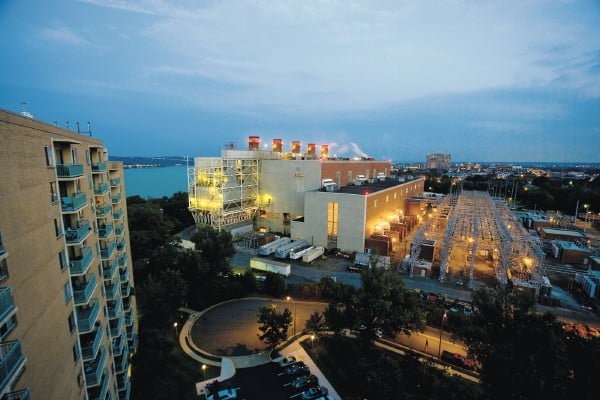Mary Harris doesn’t know where the coal that passes in front of her Alexandria home comes from. Around 10 each evening, she looks out her window and sees as many as 50 railcars lined up, ready to be flipped upside down and emptied. The coal is stockpiled beside Mirant’s Potomac River Generating Station, a coal-burning plant less than 300 yards from Marina Towers Condominiums, where Harris lives. From her balcony, she can see the transmission lines, where power from the generating station is sent to a grid and then sold to power companies.
The Potomac River Generating Station’s first unit began operating in 1949, when Old Town was more industrial; it has since become mostly residential. Harris and her husband bought their unit in 1994 because it was less expensive than condos in other parts of the city. They saw the coal plant from their balcony but also saw the Potomac River. Says Harris: “I thought, ‘How could the plant be there and not have the best available technologies and be totally clean?’ ”
After living in Ukraine for two years, Harris moved back to the condo in 2001. She noticed dust accumulating on her tables and windowsills; she’d clean them, and they’d be covered the next day.
When the Bush administration took over in 2001, Eric Schaeffer was director of the Environmental Protection Agency office charged with ensuring that power plants comply with the Clean Air Act. He’d filed suit against large utility companies, and the legal action helped cut pollution from coal plants. But he says the Bush administration started to dismantle progress he’d made in the Clinton years, causing him to quit.
The administration claimed that without more flexibility, there’d be blackouts and energy shortages. In 2002, Schaeffer wrote in the Washington Monthly: “White House staff and the Energy Department, working closely with lobbyists for the same companies we had sued, directed EPA to expand loopholes that allow 40- or 50-year-old power plants to continue pumping out 12 million tons of sulfur dioxide a year, without implementing modern pollution controls.”
The EPA issues National Ambient Air Quality Standards for six pollutants, including particulate matter. The standards apply to what’s allowed in the outdoor air. The agency said in 2006 that it had issued “the strongest national air quality standards in the country’s history,” lowering the daily limit for fine particles by nearly 50 percent. But the EPA was criticized by its Clean Air Scientific Advisory Committee for failing also to lower the annual fine-particle standard.
“It was a half-a-loaf decision,” says Schaeffer, executive director of the Environmental Integrity Project in DC.
The EPA suffered a setback in July, when a federal appeals court rejected the Clean Air Interstate Rule, which would have permanently capped emissions of sulfur dioxide and nitrogen oxides from power plants, controlling pollution that moves across states. The rule would have allowed utility companies to participate in a “cap and trade” system, buying and selling pollution credits to meet standards. The court said the EPA didn’t have that authority. “When you have a major rule get shot down, the agency has to press restart,” says Schaeffer. “That takes years.”
Mercury emissions from coal plants are also a concern because mercury can get into waterways—a reason the EPA and the FDA issue advisories on how much fish is safe for pregnant women and children. In February, a federal appeals court criticized the EPA’s approach to limiting mercury from coal plants, saying it had ignored science and searched for loopholes.
The coal industry is trying to clean up its image. Americans for Balanced Energy Choices—funded by railroads, coal producers, and utilities—launched a $40-million ad campaign to tell the public about the importance of coal.
“I get a little frustrated with Al Gore when he says there ought to be a moratorium on all new plants,” says Kraig Naasz of the National Mining Association. According to the NMA, new plants emit 70 to 90 percent fewer pollutants than the plants they typically replace. “First, you have to consider what the demand for energy and electricity in this country is going to be. How else are you going to get there?”
According to PJM Interconnection, a regional transmission organization, the Washington region is using 22 percent more electricity than it did ten years ago. Bob Driscoll, CEO of Mirant Mid-Atlantic, which owns the Alexandria plant, says the region should expect blackouts in the next few years if significant investment in energy infrastructure isn’t made. Says Driscoll: “What we can’t afford today is to have plants go offline.” To meet energy needs, he says, the region must build new power plants and transmission lines.
Mike Stumpf has managed the Alexandria power plant since 2006. It’s exciting, he says, to generate nearly 500 megawatts of the region’s electricity. That’s enough to power roughly 500,000 homes.
Wearing earplugs, Stumpf walks near the plant’s coal pulverizers. Pipes caked with soot travel in all directions, transporting water into the plant from the Potomac. Upstairs are the boiler and five turbines. The floor shakes even though the plant isn’t operating at capacity—Stumpf says only two generators are running today.
Virginia’s Department of Environmental Quality limited the plant’s operations in 2007—restricting the units that can operate—to reduce sulfur-dioxide emissions.
What concerns local residents is how short the stacks are. Most coal-fired plants shoot the bad stuff—sulfur dioxide and fine particles—from stacks 300 to 700 feet high, dispersing it farther away than the short stacks do. In Alexandria, the stacks are 165 feet tall. Some residents believe pollutants are raining down on them.
The Clean Air Act has limitations. When the act was amended in 1977, Congress made a compromise: Any existing coal plant wouldn’t have to update pollution controls. More than 200 of these “grandfathered” plants operate today, including Mirant’s in Alexandria.
It can cost large plants up to $400 million to install scrubbers, which take 95 percent of the sulfur dioxide out of the exhaust. The Alexandria plant’s operators say Mirant says it doesn’t have space for one because the plant is located on less than 25 acres in an urban environment.
To reduce sulfur-dioxide emissions, Mirant has developed a technique that injects a material called trona into the combustion process. Trona chemically reacts to absorb the sulfur dioxide; Mirant says emissions at the plant are down by 70 percent. The company has also proposed a “virtual” increase in the height of the stacks—flue gases from five stacks would be merged into two, and larger fans would be installed—thereby shooting emissions higher into the atmosphere. As part of a settlement agreement reached with the city of Alexandria in July, Mirant will be investing $34 million in additional pollution-control technology.
Mary Harris’s eyes water and itch year-round. She can’t trace her symptoms to coal, but the discomfort seems to disappear when she’s not home.
It’s nearly impossible to prove dirty air hurts anyone. “It’s not like death certificates say, ‘He died from dirty air,’ ” says Frank O’Donnell, director of Clean Air Watch. While trucks and cars are the number-one culprit, coal-fired power plants are the second. Some particles are so small that they pass through the lungs into the bloodstream.
Stumpf understands why residents living nearby worry about what’s coming out of Mirant. He thinks their concerns result from not understanding what goes on inside. Stumpf, who takes the public on tours of the facility, says he doesn’t think twice about breathing the air inside.
But coal-burning plants are a concern to public-health officials. Along with higher rates of asthma attacks among children, people exposed to higher levels of fine particulate matter have an increased risk of cardiovascular disease. Jonathan Levy, an associate professor at the Harvard School of Public Health, has estimated that, based on 1999 emissions, 59 premature deaths a year could be attributed to pollutants from the Potomac River Generating Station’s stacks.
“The air is much cleaner than it was 10 or 12 years ago, but we still don’t consider the air clean,” says O’Donnell. “The DC area violates federal health standards for several known air pollutants, like smog and fine particle matter. Both can send kids with asthma to the hospital.”
Dr. Charles Konigsberg, recently retired director of Alexandria’s Health Department, heard the Alexandria residents’ concerns and called the Centers for Disease Control and Prevention’s Agency for Toxic Substances and Disease Registry, which agreed to study air quality around the plant; results haven’t been released.
“Mirant will tell you they meet the National Ambient Air Quality standards and all standards for a plant ‘grandfathered’ in,” Koningsberg says. “But other people will say that’s not good enough.”
This article first appeared in the September 2008 issue of The Washingtonian. For more articles like it, click here.


















